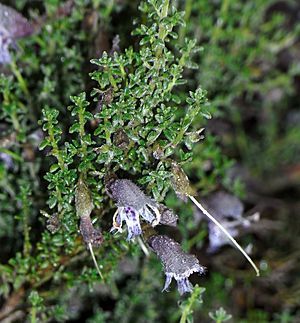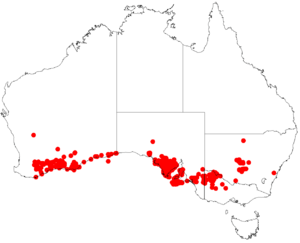Small-leaved mint-bush facts for kids
Quick facts for kids Small-leaved mint-bush |
|
|---|---|
 |
|
| Subspecies microphylla | |
| Scientific classification | |
| Genus: |
Prostanthera
|
| Species: |
serpyllifolia
|
 |
|
| Occurrence data from AVH | |
| Synonyms | |
|
Cryphia serpyllifolia R.Br. |
|
The Prostanthera serpyllifolia, also known as the small-leaved mint-bush, is a beautiful flowering plant. It belongs to the mint family, called Lamiaceae. This special shrub grows only in southern Australia. It's usually a small plant with tiny, egg-shaped leaves. Its flowers can be bright pink, red, or even a shiny bluish-green!
What Does It Look Like?
The small-leaved mint-bush is a small shrub. It can grow flat on the ground or stand up to about 0.5 meters (about 1.5 feet) tall. Its branches are often covered in soft white hairs.
The leaves are shaped like tiny eggs or are broadly oval. They are very small, usually about 1.5 to 3 millimeters long and 0.7 to 1.3 millimeters wide. Some leaves attach directly to the stem, while others have a very short stalk (called a petiole) up to 1.5 millimeters long.
The flowers grow where the leaves meet the stem. Each flower sits on a small stalk (called a pedicel) that is 1 to 5 millimeters long. At the base of the flower's outer leaves (called sepals) are tiny leaf-like parts (called bracteoles) that are usually 2 to 4 millimeters long.
The sepals are 5 to 7.5 millimeters long and form a tube. The colorful petals are bright pink to red. Sometimes they are white near the bottom or have a yellow tint. They can even be a metallic bluish-green! The petals are 15 to 22 millimeters long and form a tube. The flowering time is usually in April or from June to December.
How Was It Named?
The small-leaved mint-bush was first officially described in 1810. A famous botanist named Robert Brown gave it the name Cryphia serpyllifolia. He wrote about it in his book Prodromus Florae Novae Hollandiae et Insulae Van Diemen. He found the plant in South Australia, on the southern Eyre Peninsula.
Later, in 1895, another botanist named John Isaac Briquet changed its name to Prostanthera serpyllifolia. This is the name we use today.
In 1984, a scientist named Barry Conn looked closely at the small-leaved mint-bush. He found that there are two slightly different types, which he called subspecies. These subspecies are:
- Prostanthera serpyllifolia subsp. microphylla: This type has leaves that are mostly 1.5 to 3 millimeters long and 0.5 to 1 millimeter wide. They are usually attached directly to the stem or have a very short stalk.
- Prostanthera serpyllifolia subsp. serpyllifolia: This type has slightly larger leaves, mostly 4 to 13 millimeters long and 1 to 4 millimeters wide. These leaves usually have a short stalk that is 0.5 to 1.5 millimeters long.
Where Does It Grow?
The small-leaved mint-bush grows in several parts of Australia. You can find it in New South Wales, Victoria, South Australia, and Western Australia. It often grows in areas with "mallee" trees and shrubs. These plants usually grow in sandy or rocky soils, sometimes on limestone or a similar rock called calcrete.
The subspecies microphylla grows in New South Wales, west of a town called West Wyalong. It also grows in the far northwest of Victoria, the southeast of South Australia, and along the southern coast of Western Australia.
The subspecies serpyllifolia is found on the Yorke Peninsula and Eyre Peninsulas in South Australia. There is also one known place where it grows in the southwest of Western Australia.

